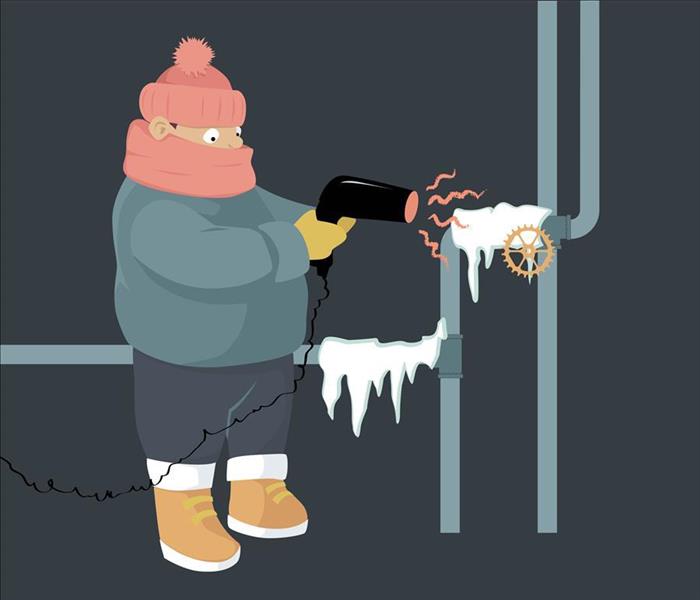A Guide to Dealing with Frozen Pipes in Sandy, UT
12/27/2023 (Permalink)
Sandy, UT, with its breathtaking landscapes and serene winters, is a haven for those who appreciate the beauty of the season. However, as temperatures drop, residents are faced with the challenge of protecting their homes from the harsh effects of winter, including the dreaded issue of frozen pipes. In this comprehensive blog post, we will delve deeper into the nuances of dealing with frozen pipes in Sandy and explore a range of preventative measures and practical tips to help you navigate this winter woe effectively.
Understanding the Enemy:
Before we dive into the solutions, it's crucial to understand why pipes freeze and the potential consequences. When temperatures plummet, water inside pipes can freeze, causing them to expand. This expansion can lead to a build-up of pressure within the pipes, risking cracks or even bursts. The consequences are not only inconvenient but can result in costly repairs and water damage to your property.
Preventative Measures:
Insulation is Your Ally: The first line of defense against frozen pipes is proper insulation. Identify exposed pipes in your home, particularly those in unheated or exterior areas, and insulate them using pipe sleeves or heat tape. By adding an extra layer of protection, you create a barrier that helps retain the heat within the pipes, preventing them from freezing.
Seal the Gaps: Cold drafts can find their way into your home through gaps around doors and windows. Inspect these areas and seal any openings to prevent the intrusion of frigid air. Weatherstripping and caulking are effective tools in fortifying your home against the winter chill.
Keep the Heat On: It may be tempting to turn down the thermostat to save on energy costs, especially when you're away. However, maintaining a consistent indoor temperature is crucial in preventing frozen pipes. Set your thermostat to a level that keeps your home comfortably warm, even when you're not there. This steady warmth provides a vital layer of protection for your plumbing.
Let the Faucets Drip: On exceptionally cold nights, allowing faucets connected to vulnerable pipes to drip slowly can be a game-changer. The movement of water, even at a minimal flow, helps prevent it from stagnating and freezing within the pipes. This simple yet effective technique is particularly useful during extreme cold spells.
Cabinet Doors Open: In areas where plumbing is located inside cabinets, such as under sinks, consider opening the cabinet doors during cold weather. This allows warm air to circulate around the pipes, reducing the chances of them freezing. It's a small adjustment that can make a significant difference in maintaining the warmth needed to prevent freezing.
Thawing Frozen Pipes:
Despite your best efforts, frozen pipes may still occur. When faced with this situation, it's essential to know how to thaw them safely to avoid causing further damage.
Locate the Frozen Section: If you suspect a pipe is frozen, the first step is to identify the affected area. This may involve checking exposed pipes in unheated areas, such as basements, crawl spaces, or attics.
Apply Gentle Heat: Once the frozen section is identified, the next step is to apply gentle heat. This can be achieved using a hairdryer, heat lamp, or towels soaked in hot water. It's crucial to start at the end closest to the faucet to allow water to flow out as the ice melts.
Avoid Open Flames: While heat is essential for thawing pipes, it's crucial to avoid using open flames or high-intensity heat sources. These can damage the pipes and pose a significant safety risk. Stick to safer alternatives such as electric heating tools designed for this purpose.
Patience is Key: Thawing frozen pipes requires patience. Rushing the process can lead to complications. Allow the heat to work gradually, and monitor the thawing progress to ensure a steady and controlled resolution.
When to Seek Professional Assistance:
While many instances of frozen pipes can be handled with the tips mentioned above, there are situations where professional assistance is warranted.
Persistent Issues: If you find yourself dealing with persistent issues of frozen pipes despite taking preventive measures, it's time to consult a licensed plumber. A professional can conduct a thorough assessment of your plumbing system, identify any underlying problems, and implement effective solutions.
Uncertain Situations: If you're unsure about how to handle frozen pipes or suspect more extensive damage, it's best to err on the side of caution and seek professional help. Ignoring potential issues can lead to further damage and increased repair costs.
As winter settles into Sandy, UT, the idyllic landscapes may be accompanied by the challenges of frozen pipes. However, armed with the knowledge of preventative measures, effective thawing techniques, and the wisdom to seek professional help when needed, residents can confidently face the winter season. Remember, the key lies in preparation and a proactive approach. By taking these steps, you not only protect your home from the inconvenience of frozen pipes but also ensure a cozy and worry-free winter. Stay warm, stay informed, and let the beauty of winter in Sandy be a source of joy, not plumbing headaches.



 24/7 Emergency Service
24/7 Emergency Service
